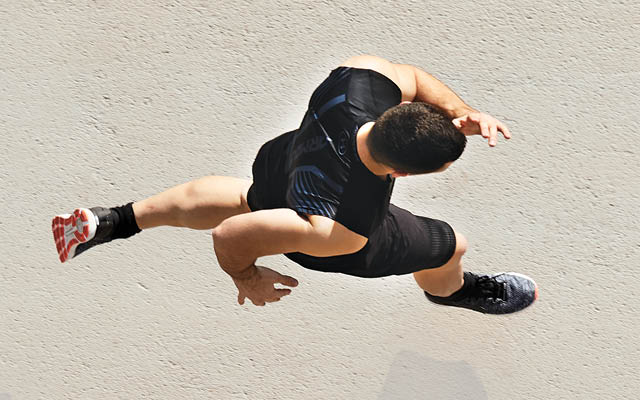Sprint-interval training (SIT) just may be the most efficient form of cardio.
But there’s a catch.
SIT is the lesser-known cousin of high-intensity interval training (HIIT). Both are characterized by short, fast bursts of intense exercise interspersed with periods of rest, yet there’s one key difference: During a HIIT workout, you push yourself to 80 to 85 percent of your maximum heart rate (MHR); in a SIT session, you approach 100 percent.
These all-out dashes of 30 seconds or less are followed by a two-minute recovery. The intervals are anaerobic: Your body needs more than just oxygen, and additional fueling comes mostly from stored carbs.
That’s the catch. SIT is extremely effective and efficient, but it requires your full effort to reap the rewards — and sprinting like there’s a tiger hot on your tail is not for everyone.
“Sprinting is nature’s way of telling your body to toughen up and rise to the occasion,” explains Life Time national education manager Abrea Wooten. “The research shows that sprinting changes us on a cellular level.”
“Sprinting is nature’s way of telling your body to toughen up and rise to the occasion.”
According to a 2019 meta-analysis of 75 PubMed studies, SIT sprinters saw a 91 percent higher reduction in body-fat percentage compared with a control group that engaged in moderate-intensity continuous training, even though the sprinters spent 71 percent less time working out. And SIT exercisers lost 39 percent more body fat than HIIT participants, though they spent 60 percent less time exercising.
Comparing SIT and HIIT, two recent meta-analyses published in Sports Medicine concluded that the training methods are similarly effective in boosting VO2 max (the maximum amount of oxygen your body can process). SIT workouts, however, required less time to produce those results.
Among SIT’s other benefits is improved mitochondrial biogenesis. The power centers in your cells, mitochondria convert food and body fat into energy. Mitochondrial biogenesis refers to the growth and division of existing mitochondria. (See “The Care and Feeding of Your Mitochondria” to discover how to tune up your body’s quadrillions of “energy factories” and avoid mitochondrial dysfunction.)
Whether your goal is better health or improved athletic performance, you need plenty of powerfully functioning mitochondria. Because of its intensity, SIT prompts the body to produce more mitochondria by creating more demand for energy inside your cells.
SIT also improves insulin sensitivity (an important marker for diabetes) and hormonal response, Wooten says.
Plus, it increases human growth hormone (HGH) as well as testosterone. HGH’s primary role involves cell regeneration, but it can also increase caloric burn and switch your body’s fuel source from carbs to fat. Testosterone aids metabolic health, contributes to muscle gain, and supports cognition, among other benefits. HGH and testosterone levels decline as we age; exercise is one way we can support them.
“Human beings aren’t designed to sit all day. From physical health to mood to social connectivity, exercise is important on so many levels,” says Wooten. “Sprint-interval training is the closest thing we have to a fountain of youth.”
Get Started
New to sprinting? Try the eight-week beginner program at “The Beginner’s Guide to Sprint Interval Training“.
This article originally appeared as “Just Sprint” in the September 2022 issue of Experience Life.





This Post Has 0 Comments